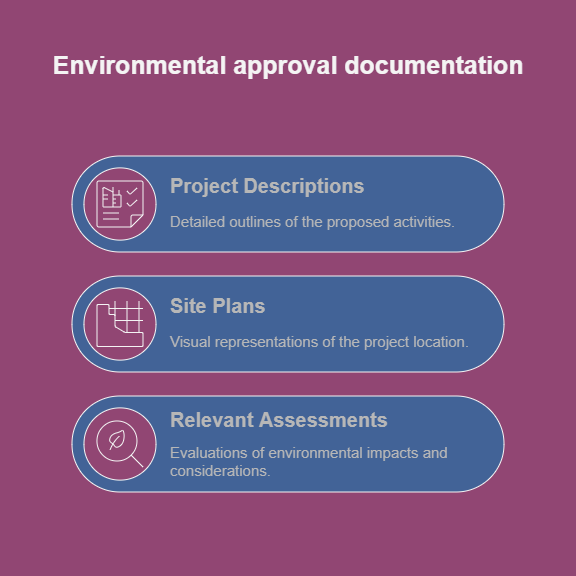Key Takeaways
Step-by-Step Guide to Navigating the Environmental Approval Process
- Introduction
- Step 1: Understand the Environmental Regulations
- Step 2: Conduct a Preliminary Environmental Assessment
- Step 3: Hire Professional Environmental Consultants
- Step 4: Prepare the Required Documentation
- Step 5: Submit the Environmental Approval Application
- Step 6: Engage with Regulatory Authorities
- Step 7: Conduct Detailed Environmental Impact Assessments
- Step 8: Implement Mitigation Measures
- Step 9: Monitor and Report on Environmental Compliance
- Step 10: Stay Updated with Regulatory Changes
- Conclusion
Introduction
Embarking on a new project can be amazing. But, the environmental approval process often feels like a maze. This is essential for everyone to understand the necessary approvals. Whether they’re going to launch a construction venture, developing land, or introducing a new product. These approvals can make or break your plans.
This guide is here to demystify the process. We break it down into manageable steps. Walk through the complexities of environmental regulations with confidence with the right information and preparation. Let’s dive in and ensure your project meets compliance. But, also contributes positively to our planet!
Step 1: Understand the Environmental Regulations
Environmental regulation understanding is the foundation of the approval process. Familiarize yourself with local, state, and federal laws. Those laws apply to your project. On the other hand, each jurisdiction may have specific requirements. So, thorough research is essential. Look for resources such as government websites, legal guides, or industry publications to gain insights. This knowledge will empower you to navigate the process more effectively.
Step 2: Conduct a Preliminary Environmental Assessment
A PEA is commonly known as a preliminary environmental assessment. It helps identify potential environmental issues before deeper analysis. This initial step involves reviewing existing site conditions and any previous environmental assessments. It allows you to pinpoint areas that may require further investigation or special attention. A preliminary environmental assessment can save time and resources. They do so by highlighting potential obstacles early on. This approach lays the groundwork for informed decision-making.
Step 3: Hire Professional Environmental Consultants
Professional environmental consultants bring expertise and experience to the approval process. They can guide you through complex regulations. This in turn helps ensure compliance with environmental standards. Consultants have the skills to conduct assessments. They can prepare documentation, and communicate effectively with regulatory bodies. So, hiring the right consultant can streamline your process. Additionally, it reduces the risk of errors. In achieving a successful outcome, their insights can be invaluable.
To get assistance timely, KPM PRO consultants are well versed in offering these services at their fingertips. Our team knows what documents are needed and how to communicate with authorities. Helping you ensure a seamless process from start to the end.
Step 4: Prepare the Required Documentation
Accurate document preparation is crucial for your environmental approval process application. This includes:
- Project descriptions
- Site plans, and
- Any relevant assessments.
Organized documentation will facilitate the review process by regulatory authorities. Make sure that all required forms are completed correctly. Also, ensure that all necessary information is included. Take your time to compile documents. It can prevent delays in your application process. Or you can hire KPM PRO experts to get your things done timely. We have years of experience doing this. So, feel free to reach out!
Step 5: Submit the Environmental Approval Application
Now, it’s time to submit your environmental approval application, once your documentation is ready. Carefully follow the submission guidelines. This ensures you provide all required materials. Must pay attention to deadlines. Check any specific formats requested by regulatory agencies. A well-prepared application enhances your chances of approval. It demonstrates your commitment to compliance. Keep a record of all communication related to your application after submission.
All seem difficult? No worries, you can get along with professionals who can do all the processes on your behalf. Rely on KPM PRO and let yourself relax.
Step 6: Engage with Regulatory Authorities
Engage with regulatory authorities can smooth the approval process. You must maintain open lines of communication. Be responsive to any inquiries or requests. Sometimes it is required for additional information. To discuss your project and address concerns, attend meetings or consultations. Build a rapport with regulators. It can foster collaboration and demonstrate your commitment to environmental stewardship. Engagement is a key to navigating any challenges that may arise.
The process isn’t too straightforward. As it requires time to manage all closely. If you find it hard to do yourself. Take a step ahead and hire specialized consultants.
Step 7: Conduct Detailed Environmental Impact Assessments
Conduct a detailed environmental impact assessment if required. This can be done to evaluate your project’s potential effects on the environment. An EIA involves a thorough analysis of various factors, including:
- Air quality
- Water resources, and
- Biodiversity
This assessment provides essential data for making informed decisions. It also aids in implementing effective mitigation measures. Engage qualified experts to conduct the EIA to ensure accuracy. You can also comply closely with regulations. The findings will be crucial for your final application.
Step 8: Implement Mitigation Measures
After completing the EIA, develop and implement mitigation measures to address any identified environmental impacts. These measures may include alterations to project design, habitat restoration, or pollution control strategies. Implementing effective mitigation demonstrates your commitment to minimizing harm and adhering to regulatory requirements. Regularly review and adjust these measures as needed to ensure continued compliance. Transparent communication about your mitigation efforts is essential for maintaining trust with stakeholders.
Step 9: Monitor and Report on Environmental Compliance
Establish a monitoring plan once you receive approval to ensure continued compliance with the relevant environmental laws. This involves continually assessing the environmental aspects of your project and ensuring that the necessary mitigation measures are being implemented. Also, maintain accurate records and prepare reports appropriately required by the relevant authorities. Monitoring ensures compliance and demonstrates a commitment toward responsibility to the environment. Act proactively towards issues that may appear in the period of monitoring.
Step 10: Stay Updated with Regulatory Changes
Environmental regulations can change with time. That’s why it’s important to stay informed about any updates that may impact your project. For this, review relevant legislation regularly and engage with industry groups. This helps you to keep abreast of new developments. Attend workshops, seminars, or webinars. Especially the ones that are focused on environmental compliance. As it enhances your knowledge. Adapting to regulatory changes helps ensure continued compliance and supports sustainable practices. This is a key to long-term success in your environmental initiatives.
Still, you feel, you need someone’s assistance? Know that, the expert team is just a message away. KPM PRO professionals take care of every aspect of the environmental approval process. Whether it be documentation gathering or communicating with authorities.
Conclusion
Navigating the environmental approval process is quite a chore, but indeed, there is clarity in complexity; it can be broken down into steps. You work in harmony with regulations and assessments, experts who help advance your project on the right track. This is your chance to prove not only compliance but also commitment to stewardship and sustainable practices in the environment. Stay proactive and agile with an eye on emerging regulations. By proper planning and hard work, you can give both your project and the environment a change for the better. Pave the way for a greener future!
FAQs:
Why is environmental approval important for businesses?
Environmental approval is important for businesses as it ensures your project meets UAE environmental standards. It also helps avoid legal penalties.
What are the key steps in the environmental approval process?
The environmental approval process involves the following key steps:
- Submit assessments
- Provide impact studies
- Comply with inspections, and
- Receive final approval.
What documents are required for environmental approval?
The documents below are required for environmental approval:
- EIA reports
- Layout plans
- Project details, and
- Compliance forms.
How long does it take to get environmental approval?
The environmental approval process takes two to eight weeks. However, it depends on project size.
Which projects require environmental approval?
Environmental approval is mostly required in Industries like:
- Construction
- Manufacturing
- Waste management, and
- Energy projects require it






